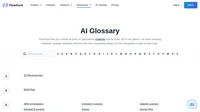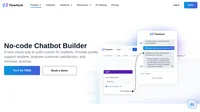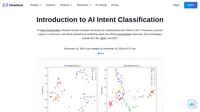Instance segmentation is a computer vision task that involves detecting and delineating each distinct object of interest appearing in an image. Unlike traditional object detection, which provides bounding boxes around objects, instance segmentation goes a step further by identifying the exact pixel-wise location of each individual object, producing a more precise and detailed understanding of the image’s content.
Instance segmentation is essential in scenarios where it’s important not only to detect objects but also to distinguish between multiple instances of the same object class and understand their precise shapes and locations within an image.
Understanding Instance Segmentation
To fully grasp what instance segmentation entails, it’s helpful to compare it with other types of image segmentation tasks: semantic segmentation and panoptic segmentation.
Difference between Instance Segmentation and Semantic Segmentation
Semantic segmentation involves classifying each pixel in an image according to a set of predefined categories or classes. This means that all pixels belonging to a certain class (e.g., “car,” “person,” “tree”) are labeled accordingly, without distinguishing between different instances of the same class. For instance, in semantic segmentation, all cars in an image would be recognized as “car” without differentiating between individual cars.
Instance segmentation, on the other hand, not only classifies each pixel but also differentiates between separate instances of the same class. This means that if there are multiple cars in an image, instance segmentation will identify and delineate each car individually, assigning unique identifiers to each one. This is crucial in applications where individual object recognition and tracking are necessary.
Difference between Instance Segmentation and Panoptic Segmentation
Panoptic segmentation is a more recent concept that combines the goals of both semantic and instance segmentation. It provides a complete scene understanding by assigning a semantic label and an instance ID to every pixel in the image. This means that it handles both “thing” classes (countable objects like people and cars) and “stuff” classes (amorphous regions like sky, road, or grass). Instance segmentation focuses primarily on “things,” detecting and segmenting individual object instances.
How Does Instance Segmentation Work?
Instance segmentation algorithms typically employ deep learning techniques, particularly convolutional neural networks (CNNs), to analyze images and generate segmentation masks for each object instance.
Key Components of Instance Segmentation Models
- Feature Extraction (Encoder):The first step in an instance segmentation model is feature extraction. An encoder network, often a CNN, processes the input image to extract meaningful features that represent the visual content.
- Region Proposal:The model proposes regions in the image that are likely to contain objects. This can be done using methods like Region Proposal Networks (RPNs), which generate bounding boxes around objects.
- Classification and Localization:For each proposed region, the model classifies the object (e.g., “car,” “person”) and refines the bounding box to more accurately encompass the object.
- Mask Prediction (Segmentation Head):The final step involves generating a segmentation mask for each object instance. This mask is a pixel-wise representation indicating which pixels belong to the object.
Popular Instance Segmentation Models
Mask R-CNN
Mask R-CNN is one of the most widely used architectures for instance segmentation. It extends the Faster R-CNN model by adding a branch for predicting segmentation masks on each Region of Interest (RoI) in parallel with the existing branch for classification and bounding box regression.
Mask R-CNN works as follows:
- Feature Extraction: An input image is passed through a backbone CNN (e.g., ResNet) to generate a feature map.
- Region Proposal Network (RPN): The feature map is then used to generate region proposals that potentially contain objects.
- RoI Align: The regions are extracted from the feature map using RoI Align, which preserves spatial alignment better than previous pooling methods.
- Prediction Heads:
- Classification and Bounding Box Regression Head: For each RoI, the model predicts the object class and refines the bounding box coordinates.
- Mask Head: A convolutional network predicts a binary mask for each RoI, indicating the exact pixels belonging to the object.
Other Models
- YOLACT: A real-time instance segmentation model that combines the speed of single-shot detection with instance segmentation capabilities.
- SOLO & SOLOv2: Fully convolutional models that segment objects by assigning instance categories to each pixel without object proposals.
- BlendMask: A model that combines top-down and bottom-up approaches, blending coarse and fine features to produce high-quality masks.
Applications of Instance Segmentation
Instance segmentation has numerous applications across various industries, providing detailed object detection and segmentation capabilities that are crucial for complex tasks.
Medical Imaging
Application: Automated analysis of medical images such as MRI, CT scans, and histopathology images.
Use Case: In medical diagnostics, instance segmentation can be used to detect and delineate individual cells, tumors, or anatomical structures. For example, segmenting nuclei in histopathology images aids in cancer detection by identifying abnormal cell growth patterns.
Example: Segmenting individual tumors in MRI scans allows radiologists to assess the size, shape, and progression of cancerous growths, facilitating treatment planning.
Autonomous Driving
Application: Perception systems in self-driving cars.
Use Case: Instance segmentation enables autonomous vehicles to accurately detect and understand the environment by separating individual objects like cars, pedestrians, cyclists, and road signs. This detailed object recognition is essential for decision-making and navigation.
Example: Instance segmentation allows a self-driving car to distinguish multiple pedestrians walking close together, enabling it to predict their movements and adjust driving accordingly.
Robotics
Application: Object manipulation and interaction in robotic systems.
Use Case: In robotics, instance segmentation allows robots to recognize and interact with individual objects in cluttered environments. This is crucial for tasks like picking and sorting items in warehouses or assembly lines.
Example: A robotic arm equipped with instance segmentation can identify and pick out specific objects from a mixed pile, such as selecting a particular type of component from a bin of assorted parts.
Satellite and Aerial Imagery
Application: Analysis of satellite and drone imagery for environmental monitoring, urban planning, and agriculture.
Use Case: Identifying and segmenting individual features such as buildings, vehicles, crops, or trees helps in resource management, disaster response, and precision agriculture.
Example: In agriculture, instance segmentation can be used to count individual trees in an orchard, assess their health, and optimize harvesting strategies.
Quality Control in Manufacturing
Application: Automated inspection and defect detection in manufacturing processes.
Use Case: Instance segmentation helps in identifying and isolating individual products or components to detect defects or anomalies, ensuring quality control.
Example: In a semiconductor manufacturing line, instance segmentation can detect and segment individual microchips, identifying manufacturing defects at a granular level.
Augmented Reality (AR)
Application: Object recognition and interaction in AR applications.
Use Case: Instance segmentation enables AR systems to understand the environment by recognizing and segmenting objects, allowing virtual elements to interact seamlessly with real-world objects.
Example: An AR application can segment individual pieces of furniture in a room, allowing users to visualize how new furniture would fit and interact within the space.
Video Analysis and Surveillance
Application: Motion tracking and behavior analysis in security systems.
Use Case: Instance segmentation in videos allows for tracking individual objects over time, providing insights into movement patterns and detecting unusual activities.
Example: In a retail environment, instance segmentation can track individual customers’ movements, aiding in store layout optimization and loss prevention.
Examples and Use Cases
To illustrate the impact of instance segmentation, consider the following detailed examples:
Medical Imaging: Cell Counting and Analysis
In pathological studies, researchers often need to count and analyze cells in microscope images. Manual counting is time-consuming and prone to human error. Instance segmentation automates this process by identifying and segmenting each cell individually.
- Process:
- Images from microscopes are fed into an instance segmentation model.
- The model identifies each cell, regardless of overlapping or varying shapes.
- Segmented cells are counted and analyzed for characteristics such as size and morphology.
- Benefits:
- Increases accuracy and efficiency in cell counting.
- Facilitates large-scale studies by processing thousands of images rapidly.
- Provides quantitative data essential for research and diagnosis.
Autonomous Driving: Pedestrian Detection
Safety in autonomous driving depends heavily on accurately detecting and reacting to pedestrians.
- Process:
- Onboard cameras capture real-time images of the environment.
- Instance segmentation models process these images to identify and segment each pedestrian.
- The system uses this information to predict pedestrian movement and adjust vehicle behavior.
- Benefits:
- Enhances safety by providing precise locations of pedestrians.
- Improves navigation in crowded urban environments.
- Helps in complying with safety regulations and standards.
Robotics: Object Sorting in Warehouses
Automation in warehouses often involves robots sorting and moving objects.
- Process:
- Cameras capture images of items on a conveyor belt.
- Instance segmentation models identify and segment individual items, even if they overlap or are in piles.
- Robots use the segmentation data to pick and sort items accurately.
- Benefits:
- Increases efficiency and speed in sorting processes.
- Reduces mishandling or damage to items.
- Allows for handling of complex assortments of products.
Satellite Imagery: Urban Development Monitoring
Monitoring urban expansion is essential for planning and environmental management.
- Process:
- Satellite images are analyzed using instance segmentation to identify and segment individual buildings.
- Changes over time are tracked by comparing segmentation results from different periods.
- Benefits:
- Provides detailed data on urban growth patterns.
- Aids in infrastructure planning and resource allocation.
- Helps in assessing environmental impact and sustainability.
How Instance Segmentation Relates to AI Automation and Chatbots
While instance segmentation is primarily associated with computer vision, it plays a significant role in the broader field of AI automation. By providing detailed visual understanding, instance segmentation enables automation systems to interact intelligently with the physical world.
Integration with AI Automation
In AI automation, systems rely on accurate perceptions to make decisions.
- Robotics Automation:
- Robots use instance segmentation to understand their environment and perform tasks autonomously.
- Example: Autonomous drones use instance segmentation to navigate and avoid obstacles.
- Manufacturing Automation:
- Automated inspection systems use instance segmentation to detect defects and ensure quality control.
Enhancing AI Capabilities in Chatbots and Virtual Assistants
While chatbots are primarily text-based, integrating instance segmentation can enhance their capabilities when combined with visual interfaces.
- Visual Chatbots:
- Customer Support:
- Users can send images of products with issues.
- The chatbot uses instance segmentation to identify the problem area and provide assistance.
- Accessibility Tools:
- For visually impaired users, AI systems can describe scenes in detail.
- Instance segmentation helps in generating more precise descriptions by identifying each object.
Advancements and Future of Instance Segmentation
Instance segmentation continues to evolve with advancements in deep learning and computational methodologies. Emerging technologies and research focus on improving accuracy, speed, and applicability in various domains.
Real-Time Instance Segmentation
Developing models capable of real-time processing is crucial for applications like autonomous driving and video surveillance.
- Techniques:
- Optimization of network architectures to reduce computational load.
- Utilizing single-shot detectors for faster inference.
- Challenges:
- Balancing speed with accuracy.
- Managing computational resources on edge devices.
Combining with Other Modalities
Integrating instance segmentation with other data types enhances system capabilities.
- Multimodal Data:
- Combining visual data with lidar, radar, or thermal imaging for more robust perception systems.
- Example: In autonomous vehicles, fusing camera images (instance segmentation) with lidar point clouds for better object detection.
Semi-Supervised and Unsupervised Learning
Reducing the reliance on large labeled datasets.
- Approaches:
- Semi-supervised learning uses a small amount of labeled data with a large amount of unlabeled data.
- Unsupervised learning aims to discover patterns without explicit labels.
- Benefits:
- Reduces the cost and effort of data annotation.
- Makes instance segmentation more accessible for specialized applications with limited data.
Edge Computing and Deployment
Implementing instance segmentation on edge devices for decentralized processing.
- Applications:
- IoT devices performing local instance segmentation for privacy and efficiency.
- Wearable devices providing real-time feedback based on visual inputs.
- Considerations:
- Optimizing models for limited computational power.
- Ensuring energy efficiency.
Instance segmentation is a pivotal component in modern computer vision, providing detailed and precise object recognition capabilities essential for a wide array of applications. By identifying and delineating each object instance in an image, it allows AI systems to interact more effectively with the physical world, enhancing automation and intelligent decision-making.
From medical imaging to autonomous vehicles, robotics, and beyond, instance segmentation continues to drive innovation and expand the possibilities of what AI can achieve. As technology advances, we can expect instance segmentation to become even more integral to AI solutions, enriching our interactions with machines and the environment.
Research on Instance Segmentation
Instance Segmentation is a crucial computer vision task that involves detecting, classifying, and segmenting each object instance within an image. It combines the objectives of object detection and semantic segmentation to provide detailed insights into image content. Here are some significant research contributions in this field:
- Learning Panoptic Segmentation from Instance Contours
This research presented a fully convolutional neural network that learns instance segmentation from semantic segmentation and instance contours, which are the boundaries of objects. The study demonstrated that instance contours, combined with semantic segmentation, yield a boundary-aware semantic segmentation of objects. By applying connected component labeling on these results, the network produces instance segmentation. The method was evaluated on the CityScapes dataset, showcasing both qualitative and quantitative performances, along with several ablation studies.
Read more - Ensembling Instance and Semantic Segmentation for Panoptic Segmentation
This paper describes a solution for the 2019 COCO panoptic segmentation task that involves performing instance and semantic segmentation separately before combining them for panoptic segmentation results. The authors enhanced performance using several expert models of Mask R-CNN to address data imbalance and adopted the HTC model for the best instance segmentation results. An ensemble strategy was applied in semantic segmentation to further boost results, achieving a PQ score of 47.1 on the 2019 COCO panoptic test-dev data.
Read more - Insight Any Instance: Promptable Instance Segmentation for Remote Sensing Images
This study addresses the challenges of instance segmentation in remote sensing images, such as the unbalanced foreground-to-background ratio and limited instance size. By proposing a new prompt paradigm, the authors designed a local prompt module and a global-to-local prompt module to model contextual information effectively. Their approach enhances instance segmentation performance by extending existing models to become promptable instance segmentation models, which can better exploit potential information from the images.
Read more
Feature Engineering and Extraction
Explore how Feature Engineering and Extraction boost AI model performance by transforming raw data into valuable insights. Learn key techniques and examples!
Introduction to AI Intent Classification
Discover how AI Intent Classification enhances interactions, boosts user satisfaction, and streamlines business operations across various sectors.



